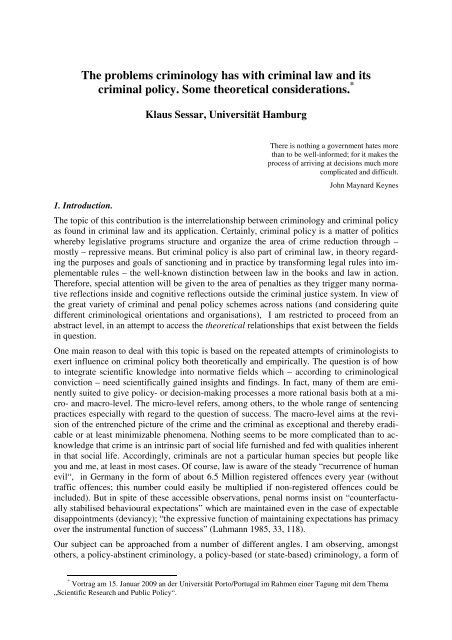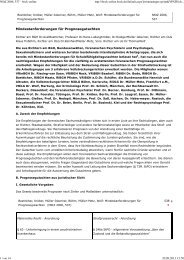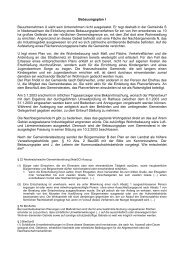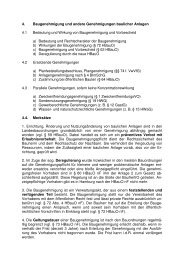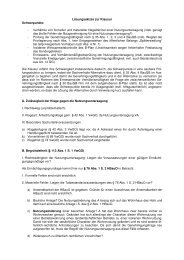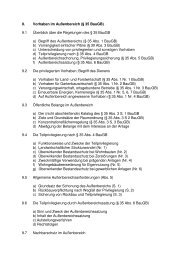Sessar Porto Problems criminology has with criminal law
Sessar Porto Problems criminology has with criminal law
Sessar Porto Problems criminology has with criminal law
You also want an ePaper? Increase the reach of your titles
YUMPU automatically turns print PDFs into web optimized ePapers that Google loves.
The problems <strong>criminology</strong> <strong>has</strong> <strong>with</strong> <strong>criminal</strong> <strong>law</strong> and its<br />
<strong>criminal</strong> policy. Some theoretical considerations. *<br />
Klaus <strong>Sessar</strong>, Universität Hamburg<br />
1. Introduction.<br />
There is nothing a government hates more<br />
than to be well-informed; for it makes the<br />
process of arriving at decisions much more<br />
complicated and difficult.<br />
John Maynard Keynes<br />
The topic of this contribution is the interrelationship between <strong>criminology</strong> and <strong>criminal</strong> policy<br />
as found in <strong>criminal</strong> <strong>law</strong> and its application. Certainly, <strong>criminal</strong> policy is a matter of politics<br />
whereby legislative programs structure and organize the area of crime reduction through –<br />
mostly – repressive means. But <strong>criminal</strong> policy is also part of <strong>criminal</strong> <strong>law</strong>, in theory regarding<br />
the purposes and goals of sanctioning and in practice by transforming legal rules into implementable<br />
rules – the well-known distinction between <strong>law</strong> in the books and <strong>law</strong> in action.<br />
Therefore, special attention will be given to the area of penalties as they trigger many normative<br />
reflections inside and cognitive reflections outside the <strong>criminal</strong> justice system. In view of<br />
the great variety of <strong>criminal</strong> and penal policy schemes across nations (and considering quite<br />
different criminological orientations and organisations), I am restricted to proceed from an<br />
abstract level, in an attempt to access the theoretical relationships that exist between the fields<br />
in question.<br />
One main reason to deal <strong>with</strong> this topic is based on the repeated attempts of criminologists to<br />
exert influence on <strong>criminal</strong> policy both theoretically and empirically. The question is of how<br />
to integrate scientific knowledge into normative fields which – according to criminological<br />
conviction – need scientifically gained insights and findings. In fact, many of them are eminently<br />
suited to give policy- or decision-making processes a more rational basis both at a micro-<br />
and macro-level. The micro-level refers, among others, to the whole range of sentencing<br />
practices especially <strong>with</strong> regard to the question of success. The macro-level aims at the revision<br />
of the entrenched picture of the crime and the <strong>criminal</strong> as exceptional and thereby eradicable<br />
or at least minimizable phenomena. Nothing seems to be more complicated than to acknowledge<br />
that crime is an intrinsic part of social life furnished and fed <strong>with</strong> qualities inherent<br />
in that social life. Accordingly, <strong>criminal</strong>s are not a particular human species but people like<br />
you and me, at least in most cases. Of course, <strong>law</strong> is aware of the steady “recurrence of human<br />
evil“, in Germany in the form of about 6.5 Million registered offences every year (<strong>with</strong>out<br />
traffic offences; this number could easily be multiplied if non-registered offences could be<br />
included). But in spite of these accessible observations, penal norms insist on “counterfactually<br />
stabilised behavioural expectations” which are maintained even in the case of expectable<br />
disappointments (deviancy); “the expressive function of maintaining expectations <strong>has</strong> primacy<br />
over the instrumental function of success” (Luhmann 1985, 33, 118).<br />
Our subject can be approached from a number of different angles. I am observing, amongst<br />
others, a policy-abstinent <strong>criminology</strong>, a policy-based (or state-based) <strong>criminology</strong>, a form of<br />
* Vortrag am 15. Januar 2009 an der Universität <strong>Porto</strong>/Portugal im Rahmen einer Tagung mit dem Thema<br />
„Scientific Research and Public Policy“.
2<br />
<strong>criminology</strong> in empirical conflict <strong>with</strong> policy and a form of <strong>criminology</strong> as an observer of<br />
policy. It is especially these last two forms that I want to address.<br />
The purpose of the following remarks is to depict some of the difficulties that <strong>criminal</strong> justice<br />
systems may have in attuning their legal principles to compelling social determinants of decision-making<br />
or in accepting empirically disclosed realities which are contradicting normative<br />
realities as they are cultivated in the legal programs. By drawing on systems theory, the assumed<br />
difficulties are theoretically transformed into problems of communication that the<br />
functions systems of “science” (<strong>criminology</strong>) and “<strong>law</strong>” (<strong>criminal</strong> <strong>law</strong>) have among each other.<br />
Empirical experiences.<br />
Empirical observations that the severity of punishment does not (or only in exceptional cases)<br />
have a deterrent effect are almost uncontested in <strong>criminology</strong> (von Hirsch et al. 1999; Entorf,<br />
Spengler 2008). In contrast, <strong>criminal</strong> <strong>law</strong> continues to justify severe punishments <strong>with</strong> their<br />
purported deterrent properties regarding the general population (general deterrence, in Germany<br />
“negative general prevention”) and individual offenders to prevent them from committing<br />
further crimes (special deterrence or special prevention). An additional preventive goal<br />
<strong>has</strong> been formulated in German <strong>criminal</strong> <strong>law</strong> as punishment is said to strengthen the citizens’<br />
confidence in the <strong>law</strong> and its enforcement; this is called “positive general prevention”. This<br />
concept, which is not a theory in our sense, is therefore neither verifiable nor falsifiable in<br />
empirical terms, but is part of the self-referential operations of the closed legal system. The<br />
conclusion from this is: Psychologically and sociologically grounded preventive sanctions on<br />
the individual and the collective level mirror the modern, science-based type of <strong>criminal</strong> <strong>law</strong>.<br />
They demonstrate that <strong>law</strong> conceives itself as part of society, acknowledging the society’s<br />
expectations in terms of guarantying safety by means of crime reduction. This is the one side<br />
of the coin. On the other side <strong>criminal</strong> <strong>law</strong> will adopt such utilitarian profiles only as long as<br />
they comply <strong>with</strong> its own internal – non-utilitarian – principles which require the <strong>law</strong>’s restoration<br />
in case of un<strong>law</strong>ful behaviour through retributive punishment. Thus, retribution and<br />
deterrence are both parts of the old self-sustaining repressive ideal which gets by <strong>with</strong>out validating<br />
causal relationships. A judge who is convinced that punishment does not deter must<br />
not change his habitual sentencing practice as deterrence is hardly more than an empirical<br />
looking label of traditional legal goals (this is regularly misunderstood by criminologists).<br />
Another example of the <strong>criminal</strong> justice system’s refusal to follow criminological findings<br />
refers to the attitudes of people towards restituição (Wiedergutmachung, redress, reparación,<br />
réparation, Schadevergoedingsmaatregel) as an alternative to traditional punishment. In many<br />
investigations, including my own in Hamburg, the willingness of the population to accept<br />
restitution instead of punishment was very large, either on the whole or dependent on the type<br />
of offense, the concrete social context, the relationship between offender and victim, etc.<br />
(<strong>Sessar</strong>, 1992; Boers, <strong>Sessar</strong> 1991). This also applies to the vast majority of victims of a crime<br />
(exceptions are victims of serious violent crimes). If we add that victims of crime (again excluding<br />
cases of multiple or serious violent victimization), do not display higher degrees of<br />
fear of crime than non-victims, then one arrives at the conclusion that the "'victim' does not<br />
provide a very suitable justification for a policy of harsh punishment' (Boers 2003, 14). The<br />
reaction of the German legislature to such results <strong>has</strong> been interesting. New statutes were enacted<br />
which allowed for a mitigation of punishment or even the dismissal of the case under<br />
the precondition that a prior victim-offender reconciliation process be carried out. The judiciary<br />
responded either by neglecting the rule or by establishing harsh requirements for the offender<br />
to consider his restituting efforts as being satisfactory, so that very few cases could<br />
actually benefit from such forms of restitution. In other words, a marked reluctance was demonstrated<br />
towards sanctions that do not follow traditional punitive standards. The findings
3<br />
provoked some unease <strong>with</strong>in the judiciary (which was included in the survey) when it became<br />
apparent that judges, and especially prosecutors, were more punitive than the public (on<br />
the basis of the Hamburg survey four groups were formed, male and female judges and male<br />
and female prosecutors; the expected largest discrepancy existed between male prosecutors<br />
<strong>with</strong> the highest and female judges <strong>with</strong> the lowest level of punitivity, <strong>Sessar</strong> 1992, 226-232).<br />
Sometimes, however, criminological results are in perfect harmony <strong>with</strong> the justice system’s<br />
need to master its daily workload. For example, after thorough investigations of the development<br />
of juvenile delinquency over time, especially of the “aging-out phenomenon”, criminologists<br />
formulated a triad of normalcy in the sense of almost ubiquitous occasional delinquent<br />
behaviour during adolescence, the rare discovery of minor delinquents and their expectable<br />
autonomous desistence from delinquent acts even in the many cases of nondiscovery<br />
(<strong>Sessar</strong> 1997). Insights of this kind helped to introduce what is called "Diversion"<br />
through which a formal <strong>criminal</strong> sentence is replaced by the dismissal of the case, <strong>with</strong> or<br />
<strong>with</strong>out preceding informal educational measures, mostly at the pre-trial level, sometimes in<br />
court. (Of course, juveniles committing serious offences are not included in the program.) For<br />
instance, in 2006 two thirds of juvenile proceedings in Germany involving chargeable minors<br />
were dealt <strong>with</strong> in this matter (in Hamburg the figure was over 80%). As one can see, criminological<br />
findings are accepted as long as they suit the legal system’s requirements – whether<br />
these be of a theoretical or, regarding case-load problems, practical nature.<br />
Another positive example is provided by Portuguese drug policy: on the basis of recommendations<br />
provided by a commission of experts the whole area surrounding illegal drugs <strong>has</strong><br />
seen a trend towards significant de<strong>criminal</strong>ization (Law 30/2000 of 29 November 2000, entered<br />
into force in July 2001). Even the possession of hard drugs for personal use in the first<br />
ten days is exempt from formal punishment. The fear expressed by some that Portugal would<br />
turn into a paradise for drug addicts <strong>has</strong> not materialized, and both the number of drug related<br />
deaths and HIV-infections was down 50% between 2000 and 2003. Cândido da Agra plausibly<br />
labeled this a "Requiem pour la guerre à la drogue" (2009; see also Quintas 2006). In the<br />
absence of further information it will be assumed that the mass of accumulated evidence concerning<br />
the social misery and the many crimes that were generated by the costly war on drugs<br />
finally lead to a re-orientation of the political system, more precisely, to a change from opinion-based<br />
policy to evidence-based policy (Davies 2004). This, indeed, is a rare event and<br />
merits much attention from other countries<br />
3. Theoretical experiments.<br />
These small examples of different degrees of acceptance displayed by the agencies of crime<br />
control to the results of criminological research seem to lack a consistent picture. It would be<br />
difficult to find an explanation which unites the divergent observations in a satisfying way.<br />
Beyond this is the much larger question as to how and to what degree <strong>criminology</strong> is accepted<br />
outside of itself that is, by crime-related disciplines outside of its own field, and in which way.<br />
In an effort to bring theory-based clarity to this situation, an analytical differentiation will be<br />
made between <strong>criminology</strong> as part of the scientific field and <strong>criminal</strong> <strong>law</strong> <strong>with</strong> its policies as<br />
part of the legal (and the political) field. The dividing line is found in societal systems or<br />
fields. To this end I refer to two sociologists from Germany and France, Niklas Luhmann and<br />
Pierre Bourdieu, who each individually developed comparable concepts to approaching the<br />
systems character of science and <strong>law</strong> (and politics).<br />
The foundation of modern systems theory is built on, though emancipated from, the structural-functional<br />
theory of Talcott Parsons. Society is composed of functional – closed - systems<br />
such as science, politics and <strong>law</strong> (alongside economy, medicine, education, art etc.).<br />
None of these systems are of greater or lesser importance than the others; that is, they are not<br />
hierarchically ordered. A system in this context is seen as developing a relatively autonomous,
4<br />
“self-regulating existence that then provides the elements out of which it continuously reconstructs<br />
itself”; this is called autopoiesis or the autopoietic principle of the social system<br />
(Milovanovic 2003, 155, 167). Furthermore, by constituting and organizing itself selfreferentially,<br />
a line is drawn between the system and its environment; for instance, the environment<br />
of <strong>law</strong> would include all other functional systems as well as society itself. Every exchange<br />
that takes place between the systems, for instance about moral questions, is an exchange<br />
through communication; moreover, those questions are generated only through communication<br />
(see Nietzsche). The problem is that “function systems structure their communication<br />
through the use of binary codes that divide the world into two values” (Bednarz 1989,<br />
xiv), for example “true/untrue” in the case of science, “legal/illegal” in the case of <strong>law</strong>, etc.;<br />
Luhmann 1989, 44-50). Thus, if science interacts <strong>with</strong> <strong>law</strong> or politics, completely diverse<br />
codes of perception, cognitive and normative structures, semantics and moral positions meet.<br />
Morality - <strong>with</strong> its distinction between good and evil - is no longer a kind of “supercode”<br />
which binds the functional domains to a set of universal moral rules. Rather it is linked to the<br />
function systems, thus forming systems-specific (economic, scientific, juridical, political etc.)<br />
modes of morality (Luhmann 1990). For scientists as scientists it is therefore often hard to<br />
understand the “legal habitus” (Bourdieu 1987) and the normative rigidity of <strong>law</strong> just as, on<br />
the other side, <strong>law</strong>yers fear the complexity of scientific results as they may undermine their<br />
closed normative principles.<br />
This theory of self-referentially closed and thereby open social systems entails considerable<br />
problems. Firstly, the reductions in communication dictate how the world will be viewed; <strong>law</strong><br />
will view it according to the aspect of justice and science will view it according to the aspect<br />
of scientific truth. Secondly, no system can adopt the standpoint of another system; science,<br />
for example, cannot view the world through the eyes of the <strong>law</strong> (of course a social scientist is<br />
free to partake in legal discourses; however in so doing he <strong>has</strong> crossed the border to the other<br />
system). Thirdly, this means that if one system desires to be “heard” by another system then<br />
its knowledge, experiences, impulses, demands, warnings, etc. must be converted into the<br />
modes of communication of the other system; the <strong>law</strong> must make scientific findings legally<br />
legible in order to understand and possibly adopt them.<br />
At this point a citation taken from Pierre Bourdieu’s “Méditations pascaliennes” will prove<br />
invaluable in helping to clarify some key points of his (and Luhmann’s) work, though it is to<br />
be noted that Bourdieu does not speak of “systems” but of “fields” (champs):<br />
“The process of differentiation of the social world which leads to the existence of autonomous<br />
fields concerns both being and knowledge. In differentiating itself, the social world produces<br />
differentiation of the modes of knowledge of the world. To each of the fields there corresponds<br />
a fundamental point of view on the world which creates its own object and finds in<br />
itself the principle of understanding and explanation appropriate to that object. To say … that<br />
‘the point of view creates the object’ means that the same ‘reality’ is the object of plurality of<br />
representations that are socially recognised but partially irreducible to each other – like the<br />
points of view socially instituted in the fields which they are the product – although they have<br />
in common a claim of universality. … The principle of vision and division and the mode of<br />
knowledge (religious, philosophical, juridical, scientific, artistic, etc. ) which prevails in a<br />
field, in association <strong>with</strong> a specific form of expression, can only be known and understood in<br />
relation to the specific legality of that field as a social microcosm” (Bourdieu 2000, 99).<br />
These forms of relative closure are not new, they now however form an intrinsic part of systems<br />
theory. Bourdieu quotes Blaise Pascal that “la loi, c’est la loi, et rien davantage” , adding<br />
that it is “irréductible et incommensurable” <strong>with</strong> the principles “d’un autre champ et au régime<br />
de vérité qu’il impose”. This is similar to sayings such as “l’art pour l’art” or “les affaires<br />
sont les affaires”; we are dealing in other words <strong>with</strong> tautologies (Bourdieu 2003, 139-
5<br />
140; Luhmann 1989, 37). Science too will not let its autonomy of defining truth be questioned<br />
by any other system or field as the standards of scientific operations derive from science itself<br />
(Kaplan 1964, 6).<br />
This somewhat complex theoretical construction regarding the inherent gap between science<br />
and politics is best illustrated by a statement of the Canadian political scientist Michael Ignatieff.<br />
Though at first a supporter of the war in Iraq, Ignatieff later came to regret his initial<br />
stand: "I have learned that a rational political judgment is something different to a rational<br />
judgment in the intellectual life" (Süddeutsche Zeitung, August 8, 2007, 7). The significance<br />
of this phrase lies in the incompatibility of political rationality and scientific rationality, not in<br />
the distinction between rationality and irrationality which can be the problem <strong>with</strong>in each of<br />
the respective systems. An old statement of the French philosopher Gaston Bachelard supports<br />
this view; he noted that compatibility cannot exist between the scientific mind and the<br />
legal mind (cited in Bourdieu 2003, 97).<br />
4. The epistemological issue.<br />
The difficulty of communication between the systems does not mean that they operate in a<br />
manner disconnected from another. On the contrary, they “are not sealed off from their environments<br />
[the society and the other social systems; K.S.] but experience changes therein as<br />
perturbations or disturbances which affect their own operation; and … in reacting to changes<br />
in their environment, they do so in terms of their own rules for reducing the complexity of<br />
that environment and thus environmental influences are always mediated through the system’s<br />
own procedures” (Jessop 1990, 358). What does this mean for the relationship between <strong>criminology</strong><br />
and <strong>criminal</strong> <strong>law</strong>? Concerning the more general relationship between science, <strong>law</strong> and<br />
politics, Luhmann is very clear: “Politics and <strong>law</strong> seek advice from science, but there can be<br />
no talk of scientific decision making. This concerns not only the rejection of ‘unusable’ knowledge<br />
by other functions systems but also a specific increase of claims and caution on the part<br />
of science itself” (Luhmann 1998, 88).<br />
However, a distinction must be made between facts and truths. The <strong>law</strong> cannot avoid facts<br />
should "the legal conditional program dictate that certain facts, which may be determined <strong>with</strong><br />
the aid of scientific knowledge, lead to corresponding conclusions. But facts! Not truths!"<br />
(Luhmann 1998, 130), sometimes not even recommendations grounded on facts; for example,<br />
the German Council of Economic Advisers Act of 1963 explicitly forbids recommendations<br />
on the part of the advisers <strong>with</strong> regard to politico-economic or socio-political measures (section<br />
2).<br />
Even scientifically gained and politically or legally needed facts are not always feasible for<br />
internal systems goals. One reason could be the minor quality of social scientific knowledge<br />
such as unclear objectives, poor research designs or methodological weaknesses. The basic<br />
problem however lies in the epistemological limitations of the social sciences. The pursuit of<br />
truth by means of empirical investigations is endless as empirical results and their interpretations<br />
are of a preliminary nature thus providing the foundation for the next hypotheses; even<br />
the most exact descriptions or predictions are only approximate, and a perfect correspondence<br />
<strong>with</strong> observation would be suspicious rather than satisfying (Kaplan 1964, 215). Social sciences<br />
including <strong>criminology</strong> must therefore be open to new options of experiencing the world,<br />
based on different views or better methods; after all, the world <strong>has</strong> moved on in the meantime.<br />
The point is that such an “epistemological modesty” is turned against the social sciences by<br />
those who, equipped <strong>with</strong> the belief in absolute certainties, search for reasons to repel disquieting<br />
findings.<br />
This then might turn out to be the genuine explanation for the recurrent reluctance of <strong>criminal</strong><br />
policy or <strong>criminal</strong> <strong>law</strong> to adopt criminological outcomes.
6<br />
5. Criminology as an observing science.<br />
Undoubtedly, <strong>criminology</strong> <strong>has</strong> generated an impressive corpus of knowledge which is, more<br />
precisely: would be able to alter some of the legally bound perceptions of reality. A few examples<br />
had already been given. They signaled first systems-specific differences of how to<br />
handle the crime problem. Further examples are scientifically directed against some obvious<br />
counterproductive elements of <strong>criminal</strong> policy and its application in <strong>criminal</strong> <strong>law</strong>. They refer,<br />
among others, to the poor rehabilitating effects of imprisonment (nothing or almost nothing<br />
works in the actual prison systems); especially the detrimental effects of severe penalties on<br />
juvenile delinquents in view of the establishment of <strong>criminal</strong> careers; the spiral between punishment<br />
- social exclusion - recidivism – harsher punishment - further exclusion – and so<br />
forth; the <strong>criminal</strong>ization of drug use <strong>with</strong> the consequence of drug related offences for procuring<br />
drugs (this is much less so in Portugal, see above); the (as I once called it) “tertiary<br />
victimization” of crime victims (<strong>Sessar</strong> 1990) or their manipulation (Elias 1993) should they<br />
be roped in for general <strong>law</strong>-and-order campaigns, and this against the victims’ repeatedly<br />
found rational attitudes towards punishment. The old adage “fiat justitia, pereat mundus” fits<br />
perfectly into what is perceived as a strictly closed social system.<br />
Findings of this kind are intended to alter the penal systems internally, or to open it from<br />
<strong>with</strong>in, that is, even the most spirited studies remain a part of the systems they criticize; they<br />
need them. There is no higher gratification available than to see one’s own insights being accepted<br />
by official policy. Therefore, for being heard it is advisable not to deviate too much<br />
from the ruling penal philosophies which in turn could mean to be swallowed by them.<br />
Should <strong>criminology</strong> desire to stop oscillating between acceptance and rejection, between participation<br />
and exclusion, between up one minute and down the next, then it <strong>has</strong> to develop its<br />
own interests and conceptions in systemic opposition to those of the penal systems (see van<br />
Swaaningen 1997, 192-193; 1999, 7-8). In fact, quite a number of efforts exist to work on<br />
<strong>criminology</strong> as an independent scientific subsystem <strong>with</strong>in the thematic field of crime and its<br />
definitions.<br />
One main example of such endeavours was the emergence of critical <strong>criminology</strong>. A fundamental<br />
version of this branch of <strong>criminology</strong> demanded that essential changes to the penal<br />
system take place, <strong>with</strong> a strong emp<strong>has</strong>is on the abolition of imprisonment. A rational justification<br />
of punishment was generally disputed (van Swaaningen 1997, 206) and the idea that<br />
violence can be overcome by the use of state violence was rejected. Indeed, “to simply respond<br />
by the use of counter-force is no less use of a power even under the title ‘resistance’,<br />
and leads us to very slippery arguments about ‘justifiable’ violence, wars, and homicides"<br />
(Henry, Milovanovic 1996, 220). A lively replacement discourse arose from such attitudes.<br />
To this discourse belonged various forms of civil reparation, conflict resolution, dispute settlement<br />
or restorative justice, <strong>with</strong> abolitionism being the point of reference for many of these<br />
substituting measures. Unnoticed by many of its representatives, abolitionism <strong>has</strong> mainly been<br />
discussed at a moral or idealistic level, not at an empirical level, and therefore it would have<br />
been "fruitful to elaborate abolitionism's theoretical foundation" (van Swaaningen 1997, 206).<br />
Critical <strong>criminology</strong> is closely associated <strong>with</strong> the labeling approach or the social-reaction<br />
approach. Some branches of labeling theory had a somewhat Marxist orientation; the <strong>criminal</strong><br />
justice system was considered to be an instrument of the ruling classes to maintain the existing<br />
social and economic order (Quinney 1974; Sack 1974; Henry, Milovanovic 1996, 141,<br />
<strong>with</strong> further references). One peg was the common experience that suspects from the lower<br />
classes were more frequently (and severely) prosecuted and punished than suspects from the<br />
upper classes. Regardless of its ideological lopsidedness this approach placed the generation<br />
of crime into the realm of crime control while neglecting (sometimes even denying) all forms<br />
of traditional crime causation.
7<br />
For its scientific architecture <strong>criminology</strong> needs more than political foundation. In fact, labeling<br />
theory incorporates a far-reaching epistemological core which was not overlooked but was<br />
largely dispensed <strong>with</strong> by political interests (see Bourdieu 2003, 75). The theoretical background<br />
is, among other things, symbolic interactionism which deals <strong>with</strong> the construction of<br />
reality through the assignment of meaning and sense to objects, persons, actions or decisions<br />
(Blumer 1969). The physical reality of objects is not questioned, but they are meaningless<br />
<strong>with</strong>out an attributed meaning; a city, for example, is neither safe nor unsafe by itself, it must<br />
be experienced and designated by the inhabitants to become safe or unsafe. This is also true<br />
<strong>with</strong> crime and <strong>criminal</strong>s. The unequal treatment of offenders of different classes was not only<br />
the discovery of inequity; it was also, maybe in the first place, the cornerstone of a new kind<br />
of epistemology: The property “offender” must be ascribed in a constituting way in order to<br />
come into existence (<strong>Sessar</strong> 2004, 63-66). Processes of this kind have been outlined as follows:<br />
“Deviance is not a property inherent in certain forms of behavior; it is a property conferred<br />
upon these forms by the audiences which directly or indirectly witness it” (Erikson<br />
1962, 308). In other words, “crime is a socially constructed and discursively constituted category”<br />
(Henry, Milovanovic 1996, 115), <strong>with</strong> the <strong>criminal</strong> justice system being the main constructor<br />
and as such being passed to <strong>criminology</strong> for further investigations from an external<br />
standpoint.<br />
The next step is to give the labeling approach an additional drive by introducing a theory of<br />
observation. Observation in this context is more than just a scientific method; it is the systems’<br />
operation to make a distinction between two sides of what is observed. Observation is<br />
structured by the aforementioned binary codes such as true/untrue in science or legal/illegal in<br />
<strong>law</strong>. Through its observing theories and investigations science distinguishes between, and<br />
thereby produces, “correct” as opposed to “false” (or vice versa); through its observing decisions<br />
<strong>law</strong> distinguishes between, and thereby produces, “right” as “opposed” to wrong (or<br />
vice versa). All distinctions based on observations are “self-made”. They are systems-specific<br />
constructions, that is, they do not refer to any external principles or universalistic theories. As<br />
such they are necessarily contingent; they are implying alternatives, variations, styles, selections.<br />
They do not detect realities - they form them - <strong>with</strong> the consequence that different versions<br />
of reality are established (Luhmann 1992, 332; 1998, 46-50).<br />
The acceptance of a theory of observation leads to some kind of epistemological bifurcation<br />
in <strong>criminology</strong>. Traditional <strong>criminology</strong> observes <strong>criminal</strong> behaviour through the investigation<br />
of structures, psyche and circumstances (Pease 2002, 948-949) by using different – and<br />
differentiating – kinds of disciplines, theories and methodologies. Modern <strong>criminology</strong> observes<br />
the behaviour of <strong>law</strong> <strong>with</strong> regard to crime and <strong>criminal</strong> behaviour through the study of<br />
the criteria employed to construct crime and to prosecute and punish persons defined as <strong>criminal</strong>s.<br />
Sociologically seen: Criminology can observe the restrictions forced on <strong>law</strong> by its own<br />
mode of operation; “it can observe the horizons of the observed system so that what they exclude<br />
becomes evident” (Luhmann 1989, 23).<br />
If crime is the outcome of self-referential processes <strong>with</strong>in the <strong>criminal</strong> <strong>law</strong> system, then similar<br />
systems-specific processes <strong>with</strong>in economy, medicine, politics or in the media must be<br />
expected should they be confronted <strong>with</strong> what is elsewhere called “crime”. One might even<br />
detect that certain crimes will be assigned functional tasks in accordance <strong>with</strong> the functional<br />
necessities of the respective systems, e. g., by way of debilitating blockages or impasses.<br />
More precisely: They may legally be crimes but are structural elements in the respective systems<br />
and must thus be protected against possible legal irritations. Areas of such functional<br />
operations are profit maximization in the economy (or in sport as an economic subcategory),<br />
defining enemies in order to combat them in politics, experiments on humans in medicine or<br />
methods of questioning in the police. Corruption is a bad thing but might keep a company<br />
alive and thereby help to secure jobs. Torture, even homicide, are in some countries (also
8<br />
Western style) acknowledged political instruments. Highly estimated political enterprises<br />
such as the war on crime because of crime’s destructive nature might by themselves be destructive,<br />
as we know from our experience <strong>with</strong> the war on drugs.<br />
Once again, none of these areas can be controlled by universal moral rules as they may disturb<br />
the autopoiesis of the particular systems. Therefore, it is not <strong>with</strong>out irony that some systems<br />
claim to control themselves, for example by Ethical Commissions in medicine, by Compliance<br />
Departments in larger companies or by Press Codes in the media; it would be worth<br />
studying the degree of their transparency and practice regarding the prevention or the protection<br />
of systems-specific <strong>criminal</strong> acts.<br />
6. The criminological observation of the political system.<br />
Special attention will be given to the political system. The traditional “war on crime” <strong>with</strong> its<br />
ever increasing number of <strong>criminal</strong> <strong>law</strong>s, harsher punishments and longer sentences and <strong>with</strong><br />
elaborate incapacitating regimes (all this much less so on the European mainland) is still dominating<br />
the agenda of legislation and <strong>law</strong> enforcement agencies and thereby will remain of<br />
interest for criminological observation (research). The well-known key phrases for such analyses<br />
are “culture of control” (Garland 2001) or “governing through crime” (Simon 2007).<br />
One may say that <strong>criminal</strong> <strong>law</strong> in close connection <strong>with</strong> <strong>criminal</strong> policy is exceeding the area<br />
of case-related crime control and is gradually developing more universal standards of governing<br />
society by, e. g., broadening the area of <strong>criminal</strong>izable human behaviour and actions.<br />
Parallel to this war on crime a much more radical system of individual and collective control<br />
<strong>has</strong> emerged. The central ideology is prevention. In many countries, health-care systems, insurance<br />
networks, anti-movements against smoking, alcohol use or drug use, community<br />
crime prevention schemes, <strong>law</strong>s against truancy, gated communities, an excessive private security<br />
industry and so forth work on the creation, or are the result, of prevention as a selfcontained<br />
pillar of society. The philosophy of this kind of prevention tries to gain the power<br />
of definition over the future by replacing the concrete person by factors of risk which make<br />
the individual increasingly superfluous. “What the new preventive policies primarily address<br />
is no longer individuals but factors, statistical correlations of heterogeneous elements. They<br />
deconstruct the concrete subject of intervention, and reconstruct a combination of factors liable<br />
to produce risk. Their primary aim is not to confront a concrete dangerous situation, but<br />
to anticipate all the possible forms of irruption of danger. … To be suspected, it is no longer<br />
necessary to manifest symptoms of dangerousness or abnormality, it is enough to display<br />
whatever characteristics the specialists responsible for the definition of the preventive policy<br />
have constituted as risk factors” (Castel 1991, 288-289).<br />
Amazing parallels exist between the new forms of crime control. They operate widely <strong>with</strong>out<br />
crime, but <strong>with</strong> fear. They are less concerned <strong>with</strong> perpetrators; rather they are concerned <strong>with</strong><br />
each and every one of us. The key phrases are “culture of fear” (again Simon 2007) or “politics<br />
of fear”, <strong>with</strong> fear being “the most powerful enemy of reason” (Gore 2007, 23). Criminology<br />
will discover that our societies are about to undergo an increasing change from a repressive<br />
type of (limited) crime control to a preventive type of (unlimited) social control.<br />
“Crime” may gradually be substituted for “risk”, which would then be the criminological way<br />
from crime society to risk society. “Risk-based control is no longer only one trend among<br />
several others, including retributive and restitutional justice, but <strong>has</strong> instead become a presence”<br />
(O’Malley 2004, 135), covering almost all segments of our life-world.<br />
One elementary feature of risk is that it is unknown; we don’t know if and when it will materialize<br />
by turning into a real danger or threat and what the consequences will be in such a<br />
case. Because of this ignorance, such an uncertainty will be compensated by control; one may<br />
call it absorption of uncertainty (Luhmann 1998, 89) through an all-encompassing high-tech
9<br />
surveillance, in the sense that: the less we know about risks the more we have to supervise the<br />
unknown. Should we, in addition to all this, follow Mary Douglas according to whom “risk is<br />
not a thing but a way of thinking” (1992, 46), then we will inherit the ultimate problem both<br />
in terms of epistemology and the justification of an overall risk prevention.<br />
7. Prospects in lieu of a conclusion<br />
René van Swaaningen once posed the question of whether <strong>with</strong> respect to sub-cultures, attachments,<br />
control, exclusion, aggression, and the like we still need <strong>criminology</strong> as sociology,<br />
psychology, political science, urban anthropology or neurology could do studies of this kind<br />
as well (1999, 7). He thought that the only important surplus value lies in <strong>criminology</strong>’s<br />
knowledge of the <strong>criminal</strong> justice system. In fact, we learned much about the complicated and<br />
biased procedures <strong>with</strong>in the police and the judiciary (the descriptive part of criminological<br />
investigations by way of which the existence and functioning of widely independent codes of<br />
practice were discovered); based on such rich material, labeling theory offered precious insights<br />
into the definitional processes leading to crime (the analytical part of investigations).<br />
The limitation of this approach was the emp<strong>has</strong>is on the political construction of crime while<br />
neglecting the more general epistemological aspects.<br />
The other limitation was the almost exclusive interest in the <strong>criminal</strong> justice system. The fact<br />
that <strong>law</strong> makes crime is not but a point of reference for autonomous communication processes<br />
in other functional systems affected by crime. As was already mentioned they take care to<br />
harmonize crime <strong>with</strong> their own self-referential goals either by denying, integrating, redefining<br />
or scandalizing it. Or they create it; should this provoke negative legal reactions they<br />
might try to delegitimize <strong>law</strong> or claim that strict negative reactions would have affect the system’s<br />
positive (functional) operations etc. This kind of communication turns crime into an<br />
object of negotiation, very often <strong>with</strong> an open (contingent) output. Especially those systems<br />
<strong>with</strong> strong function specifications have either much to win or much to lose through certain<br />
forms of crime; they may therefore be called ‘partners of the <strong>law</strong>’.<br />
Research in these areas is not unknown but is unstructured and lacks theoretical considerations.<br />
A new critical <strong>criminology</strong> could take over this large field in order to observe and to<br />
designate the functions of crime in the various social systems. When combined, the observations<br />
may result in an unexpected picture of crime as having its own indispensable place in<br />
society, despite its destructive qualities. Some of the subsequent questions will then be: Is this<br />
still old-fashioned “crime”? Or do we have to change our old-fashioned perceptions of it?<br />
References<br />
da Agra C. (2009), Requiem pour la guerre à la drogue. L’expérimentation portuguaise de dé<strong>criminal</strong>isation,<br />
Déviance et société 33, 27-49.<br />
Bednarz J. Jr. (1989), Translator’s Introduction, in Luhmann N., Ecological Communication, vii-xvi.<br />
Blumer H. (1969), Symbolic Interactionism: Perspective and Method, Englewood Cliffs, N.J..<br />
Boers K. (2003), Crime, fear of crime and the operation of crime control in the light of victim surveys and other<br />
empirical studies, Council of Europe, European Committee on Crime <strong>Problems</strong>, 22 nd Criminological Research<br />
Conference, Strasbourg, 24-26 November 2003.<br />
Boers K., <strong>Sessar</strong> K. (1991), Do people really want punishment? On the relationship between acceptance of restitution,<br />
needs for punishment, and fear of crime, in <strong>Sessar</strong> K., Kerner H.-J. (eds.), Developments in crime and<br />
crime control research. German Studies on Victims, Offenders, and the Public, New York et al., Springer, 126-<br />
149.<br />
Bourdieu P. (1987), The Force of Law: Toward a Sociology of the Juridical Field, Hastings Law Journal 38,<br />
814-853.
10<br />
Bourdieu P. (1997), Pascalian Meditions, Stanford, Stanford University Press.<br />
Castel R. (1991), From Dangerousness to Risk, in Burchell G., Gordon, C., Miller, P. (eds.), The Foucault Effect:<br />
Studies in Governmentality, Chicago, University of Chicago Press, 281-298.<br />
Davies, P. (2004), Is Evidence-Based Government Possible? Jerry Lee Lecture 2004<br />
(http://www.nationalschool.gov.uk/policyhub/downloads/JerryLeeLecture1202041.pdf)<br />
Douglas M. (1992), Risk and Blame: Essays in Cultural Theory, London, Routledge.<br />
Elias R. (1993), Victims Still: The Political Manipulation of Crime Victims, Newbury Park, Sage.<br />
Entorf H., Spengler H. (2008), Is Being ‘Soft on Crime’ the Solution on Rising Crime Rates? Evidence from<br />
Germany, Deutsches Institut für Wirtschaftsforschung (German Institute for Economic Research) Berlin, Discussion<br />
Papers 837, Berlin (http://www.diw.de/english/products/publications/discussion_papers/27539.html).<br />
Erikson K. T. (1962), Notes on the Sociology of Deviance, Social <strong>Problems</strong> 9, 307-314.<br />
Garland D. (2001), The Culture of Control. Crime and Social Order in Contemporary Society, Oxford, Oxford<br />
University Press.<br />
Gore A. (2007), The Assault on Reason, New York, The Penguin Press.<br />
Henry St., Milovanovic D. (1996), Constitutive Criminology. Beyond Postmodernism, London, Sage.<br />
von Hirsch A., Bottoms A. E., Burney E., Wikström, P.-O. (1999), Criminal Deterrence and Sentencing Severity.<br />
An Analysis of Recent Research, Oxford et al.<br />
Jessop B. (1990), State Theory: Putting the Capitalist State in its Place, Cambridge, U.K., Polity Press.<br />
Kaplan A. (1964), The Conduct of Inquiry. Methodology for Behavioral Science, San Francisco, Chandler Publishing<br />
Company.<br />
Luhmann N. (1985), A sociological theory of <strong>law</strong>, London et al., Routledge & Kegan Paul.<br />
Luhmann N. (1989), Ecological Communication, Chicago, University of Chicago Press.<br />
Luhmann N. (1990), Paradigm lost: Über die ethische Reflexion der Moral, Frankfurt/Main, Suhrkamp.<br />
Luhmann N. (1992), Die Wissenschaft der Gesellschaft, Frankfurt/Main, Suhrkamp.<br />
Luhmann N. (1998), Observations on Modernity, Stanford, Stanford University Press.<br />
O’Malley P. (2004), Risk, Uncertainty and Government, London et al., Glasshouse Press.<br />
Milovanovic D. (2003), An Introduction to the Sociology of Law, Monsey N. Y., Criminal Justice Press.<br />
Pease K. (2002), Crime Reduction, in Maguire M., Morgan R., Reiner R. (eds.), The Oxford Handbook of Criminology,<br />
3 rd ed., Oxford, Oxford University Press, 947-979.<br />
Quinney R. (1994), Critique of the Legal Order, Boston, Little Brown.<br />
Quintas J. (2006), Regulação legal do consume de drogas: impactos da experiência portuguesa da descrimininalização,<br />
<strong>Porto</strong> (unpublished Dissertation).<br />
Sack F. (1974), Definition von Kriminalität als politisches Handeln: der labeling approach, in Arbeitskreis Junger<br />
Kriminologen (ed.), Kritische Kriminologie. Positionen, Kontroversen und Perspektiven, München, Juventa,<br />
18-43.<br />
<strong>Sessar</strong> K. (1990), Tertiary Victimization: A Case of the Politically Abused Crime Victim, in Ga<strong>law</strong>ay B., Hudson<br />
J. (eds), Criminal Justice, Restitution, and Reconciliation, Monsey, N. Y., Willow Tree Press, 37-45.<br />
<strong>Sessar</strong> K. (1997), Kriminologische Erkenntnisse zur Entwicklung und zum Verlauf von Jugendkriminalität und<br />
Folgerungen für die Kriminalpolitik, in Dünkel F., van Kalmthout A., Schüler-Springorum H. (eds.), Entwicklungstendenzen<br />
und Reformstrategien im Jugendstrafrecht im europäischen Vergleich, Mönchengladbach, Forum,<br />
67-85.<br />
<strong>Sessar</strong> K. (2004), Verbrechen als soziale Konstruktion. Eine kriminologische Vorlesung, in Karliczek K.-M.<br />
(ed), Kriminologische Erkundungen, Wissenschaftliches Symposium aus Anlass des 65. Geburtstages von Klaus<br />
<strong>Sessar</strong>, Münster, LIT-Verlag, 32-77.<br />
Simon J. (2007), Governing Through Crime. How the War on Crime Transformed American Democracy and<br />
Created a Culture of Fear, New York, Oxford University Press.<br />
van Swaaningen R. (1997), Critical Criminology. Visions from Europe, London, Sage.
van Swaaningen R. (1999), Reclaiming critical <strong>criminology</strong>: Social justice and the European tradition, Theoretical<br />
Criminology 3, 5-28.<br />
11


